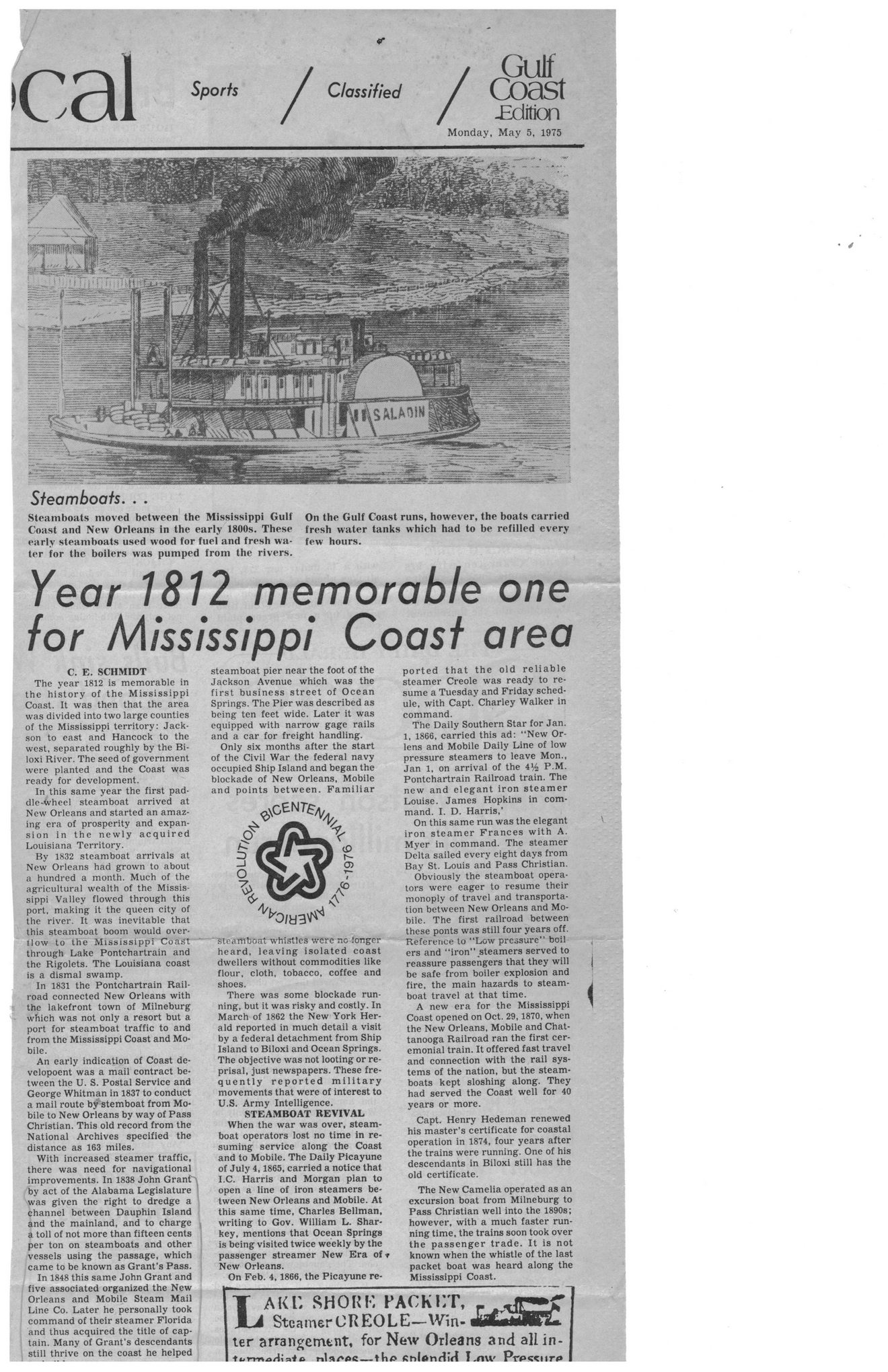This text was obtained via automated optical character recognition.
It has not been edited and may therefore contain several errors.
cal Sports / Classified / Gulf Coast -Edition Monday, May 5, 1975 Steamboats. . . Steamboats moved between the Mississippi Gulf Coast and New Orleans in the early 1800s. These earlv steamboats used wood for fuel and fresh water for the boilers was pumped from the rivers. On the Gulf Coast runs, however, the boats carried fresh water tanks which had to be refilled every few hours. Year 1812 memorable one for Mississippi Coast area C. E. SCHMIDT The year 1812 is memorable in the history ot the Mississippi Coast. It was then that the area was divided into two large counties of the Mississippi territory: Jackson to east and Hancock to the west, separated roughly by the Biloxi River. The seed of government were planted and the Coast was ready for development. In this same year the first pad-dle-<vheel steamboat arrived at New Orleans and started an amazing era of prosperity and expansion in the newly acquired Louisiana Territory. By 1832 steamboat arrivals at New Orleans had grown to about a hundred a month. Much of the agricultural wealth of the Mississippi Valley flowed through this port, making it the queen city of the river. It was inevitable that this steamboat boom would overflow to the Mississippi Coatft ~~ through Lake Pontchartrain and the Rigolets. The Louisiana coast is a dismal swamp. In 1831 the Pontchartrain Railroad connected New Orleans with the lakefront town of Milneburg which was not only a resort but a port for steamboat traffic to and from the Mississippi Coast and Mobile. An early indication of Coast de-velopoent was a mail contract between the U. S. Postal Service and George Whitman in 1837 to conduct a mail route b^stemboat from Mo* bile to New Orleans by way of Pass Christian. This old record from the National Archives specified the distance as 163 miles. With increased steamer traffic, there was need for navigational improvements. In 1838 John Grants by act of the Alabama Legislature 1 was given the right to dredge a 1 channel between Dauphin Island < and the mainland, and to charge ; a toll of not more than fifteen cents per ton on steamboats and other vessels using the passage, which came to be known as Grant’s Pass. In 1848 this same John Grant and five associated organized the New Orleans and Mobile Steam Mail Line Co. Later he personally took command of their steamer Florida and thus acquired the title of captain. Many of Grant’s descendants still thrive on the coast he helped steamboat pier near the foot of the Jackson Avenue which was the first business street of Ocean Springs. The Pier was described as being ten feet wide. Later it was equipped with narrow gage rails and a car for freight handling. Only six months after the start of the Civil War the federal navy occupied Ship Island and began the blockade of New Orleans, Mobile and points between. Familiar ' Slfeirnboat whistles were nc longer heard, leaving isolated coast dwellers without commodities like flour, cloth, tobacco, coffee and shoes. There was some blockade running, but it was risky and costly. In March of 1862 the New York Herald reported in much detail a visit by a federal detachment from Ship Island to Biloxi and Ocean Springs. The objective was not looting or reprisal, just newspapers. These fre-quently reported military movements that were of interest to U.S. Army Intelligence. STEAMBOAT REVIVAL When the war was over, steamboat operators lost no time in resuming service along the Coast and to Mobile. The Daily Picayune of July 4,1865, carried a notice that I.C. Harris and Morgan plan to open a line of iron steamers between New Orleans and Mobile. At this same time, Charles Bellman, writing to Gov. William L. Sharkey, mentions that Ocean Springs is being visited twice weekly by the passenger streamer New Era of t New Orleans. On Feb. 4, 1866, the Picayune re- ported that the old reliable steamer Creole was ready to resume a Tuesday and Friday schedule, with Capt. Charley Walker in command. The Daily Southern Star for Jan. 1, 1866, carried this ad: “New Or-lens and Mobile Daily Line of low pressure steamers to leave Mon., Jan 1, on arrival of the 4% P.M. Pontchartrain Railroad train. The new and elegant iron steamer Louise. James Hopkins in command. I. D. Harris,’ On this same run was the elegant iron steamer Frances with A. Myer in command. The steamer Delta sailed every eight days from Bay St. Louis and Pass Christian. Obviously the steamboat operators were eager to resume their monoply of travel and transportation between New Orleans and Mobile. The first railroad between these ponts was still four years off. Reference to "Low pressure” boil ers and “iron” steamers served to reassure passengers that they will be safe from boiler explosion and fire, the main hazards to steamboat travel at that time. A new era for the Mississippi Coast opened on Oct. 29,1870, when the New Orleans, Mobile and Chattanooga Railroad ran the first ceremonial train. It offered fast travel and connection with the rail systems of the nation, but the steamboats kept sloshing along. They had served the Coast well for 40 years or more. Capt. Henry Hedeman renewed his master’s certificate for coastal operation in 1874, four years after the trains were running. One of his descendants in Biloxi still has the old certificate. The New Camelia operated as an excursion boat from Milneburg to Pass Christian well into the 1890s; however, with a much faster running time, the trains soon took over the passenger trade. It is not known when the whistle of the last packet boat was heard along the Mississippi Coast. Laki: shore packet, Steamer CREOLE—Winter arrangemtnt, for New Orleans and all in- tbmid/fiaifi fihlflntiM I*AU' pTP«lirP

Hancock County History General Newspaper Clippings 1812-Steamboats-Creole1